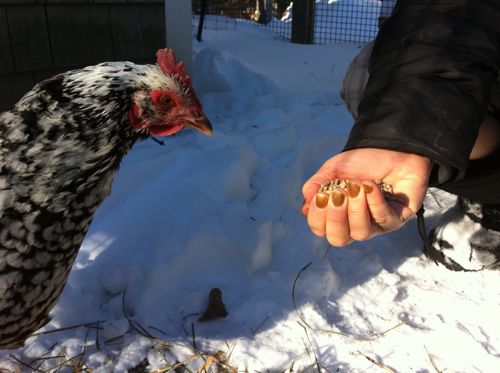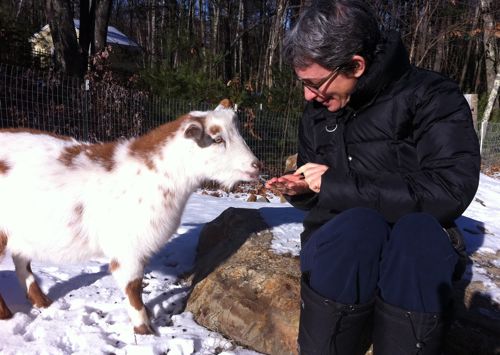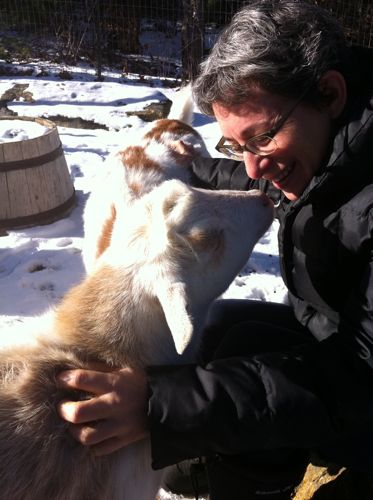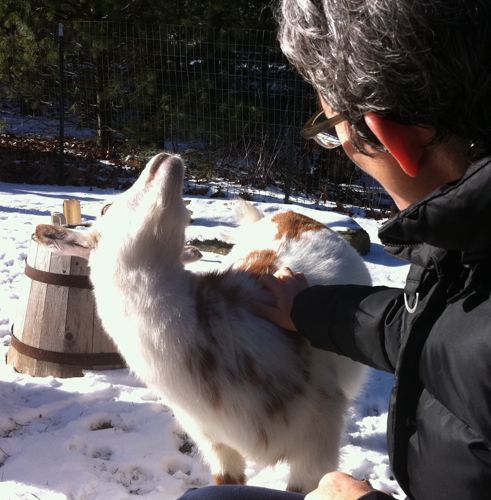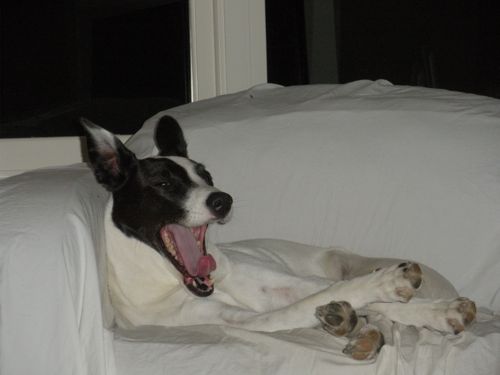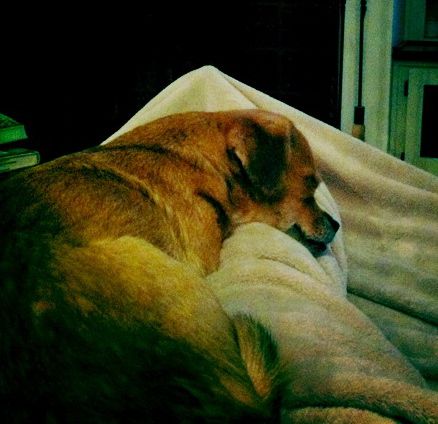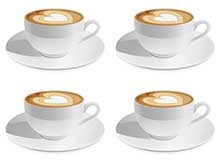Petunia died on Christmas Day, which, honestly, was a few days longer than I thought she’d last. She was one of my retirees. Hadn’t laid an egg for probably a year and a half. Her best production days were more than three years ago. She and Marge, who died last summer, were my two New Hampshire Reds, a breed I lucked into getting when a neighbor ordered extras from a hatchery in October of 2004. They’re brown-egg layers, friendly, docile and good foragers. I like how basic and sensible they look. Fancy chickens are fine, but the New Hampshire Reds look purposeful. Like chickens on a “real” farm should. Petunia’s side-kick, Marge, was the noisiest hen I’ve ever had. (You can hear Marge here.) She’d cackle and cluck and let you know her opinion on everything. Petunia never said a word, but always seemed to be in agreement. They weren’t aggressive, but they had stature and were at the top of the pecking order. Even Petunia, in her last days, was respected by the other hens.
To my knowledge, no one has studied aging chickens. No one has been interested in them. On commercial farms, laying hens are disposed of by their second molt (before their third year.) How to care for aging hens hasn’t been on a list of the backyard henkeeper’s concerns either, that is, not until recently. We lose more hens to predators and disease than to old age. This has been true for me. But it’s changing. I’ve kept chickens for more than fifteen years, and it’s only in the last few years that I’ve had elderly hens to care for and bury.
When a hen dies, we want to know why. We all make guesses, but the only way to tell for sure is to do a post-mortem. There are labs that do autopsies on birds, but these are state labs whose purpose is to protect public health and agricultural interests – they’re not there to worry about the death of an individual old hen. If the lab is willing to take your bird, you need to get it to them freshly dead and there’s a steep fee (if you’ve had other experiences, let me know.)
Last year I attended an autopsy workshop at the New England Poultry Congress. I watched an expert open up several young roosters. All were healthy. All were male. I don’t process my own birds for meat, so this was the first time I’d seen all of the innards intact (and not wrapped in paper, like a supermarket broiler.) Since then, I’ve done post-mortems on three of my own birds.
As I said, most of us make guesses about what ails our birds. We’re often wrong. Marge had died of being an internal layer (for more about her do a blog archive search.) When I opened Marge up there were egg whites and a few yolks in the body cavity, and a stench from the peritonitis that that caused. So, when Petunia, her sister, looked poorly, and had an abdomen that sloshed like a water balloon, I assumed that she was dying of the same thing.
This time, because I am recovering from surgery, Steve did the autopsy. I sat in a chair in the garage and watched as he gamely opened her up. He hadn’t been to the workshop, so I directed. Obviously, neither of us is an expert, but the more we do, the more we learn. I expected to see brown, infected fluid and gelatinous whites pour out. I was wrong. Petunia’s body cavity was filled with fluid (the healthy birds are the workshop had none) but hers was clear. The birds at the autopsy workshop had thin white membranes holding smooth, distinctive organs together. Petunia had twisted, misshapen masses. Petunia’s ovary, or what I think was her ovary, appeared to be in several places, embedded in the liver and surrounding the heart. Small globs of yolk were attached to it. I couldn’t easily identify the organs as most of them were knotted together and in convoluted shapes. The membranes around them were lumpy and opaque. I don’t know enough to know what she died of exactly, but I could tell that her problems weren’t due to everyone’s first guess, which always seems to be a bound egg. There were no eggs forming in her reproductive tract. And since there were no eggs in the fluids, it wasn’t my first guess of internal laying, either. I know enough to know that her internal organs were diseased. I think this is typical of older hens. I saw it in Ginger and Marge, two other hens that I’ve done autopsies on. All had enlarged, thickened, discolored ovaries and other organs that don’t look at all like the diagrams in the anatomy books.
Chickens can live with injuries and diseases that we couldn’t bear. There’s a disconnect between what’s going on inside and how they register that in their brains. As a prey animal, it’s best not to look different from the rest of the flock. The weak get taken first. They’re hard-wired to get on with life. Of course, they’re not impervious to pain, but they experience it in a different way than us. Which is why, although I knew that Petunia would die soon, I didn’t think I needed to “end her suffering.” She could go about her last hours in a familiar place and die peacefully. Up until the end Petunia was eating, and finding a sunny place to sit in. It’s not that she was stoic or brave. She was simply being what she was, a chicken.
I will be placing a chick order soon. I’ve got two New Hampshire Reds on the list.
(I took photos, but they are, of course, graphic. Would you want to see them? I know that many people share this blog with their children, so I thought I’d ask first.)
